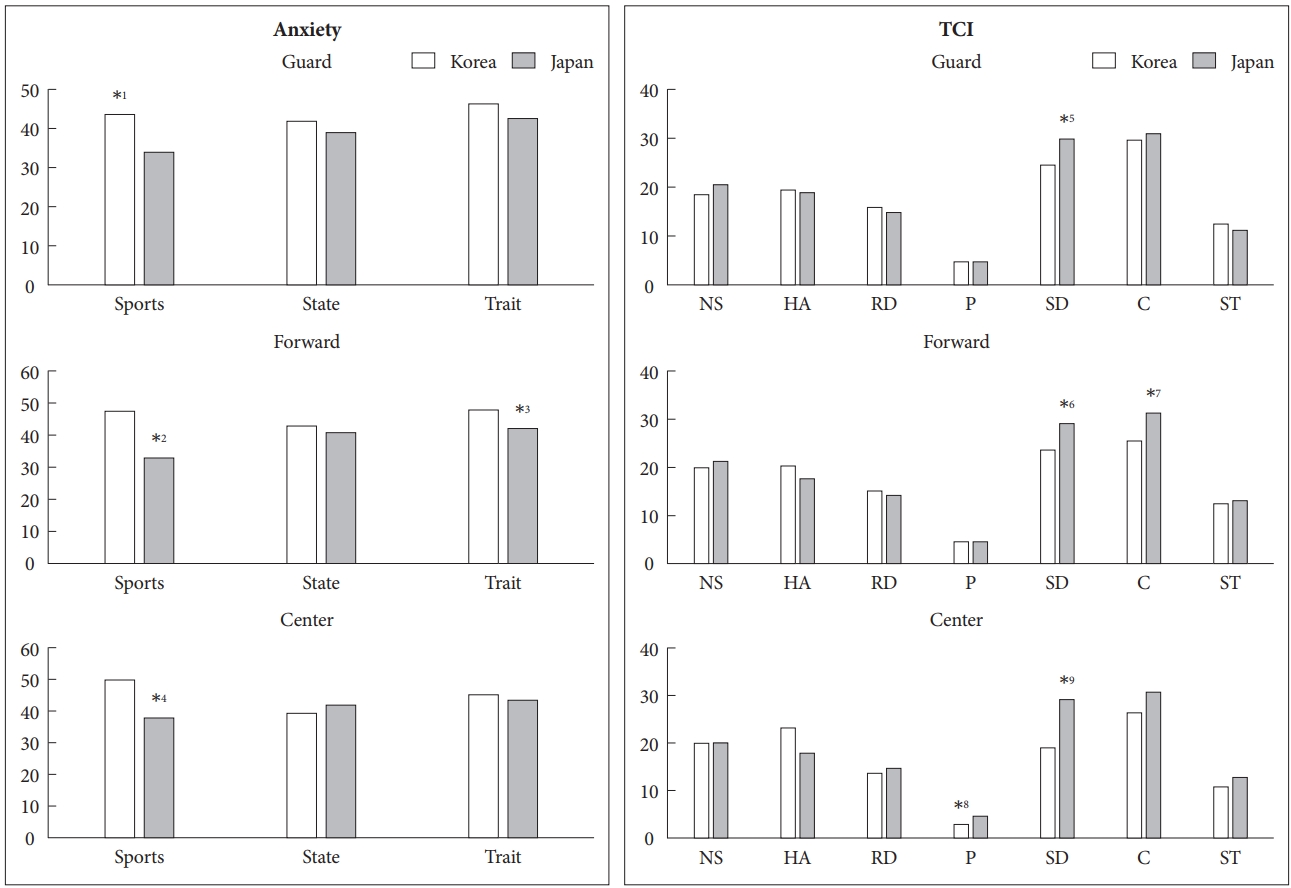 |
 |
- Search
| Psychiatry Investig > Volume 16(7); 2019 > Article |
|
Abstract
Objective
Methods
Results
The authors have no potential conflicts of interest to disclose.
Author Contributions
Conceptualization: Doug Hyun Han. Data curation: Eun Joo Ha. Formal analysis: Doug Hyun Han. Funding acquistion: Doug Hyun Han. Investigation: Kyoung Doo Kang. Methodology: Doug Hyun Han. Project administration: Kyouung Doo Kang. Resource: Eun Joo Ha. Software: Eun Joo Ha, Kyoung Doo Kang, Doug Hyun Han. Supervision: Doug Hyun Han. Validation: Doug Hyun Han. Visualization: Eun Joo Ha. Writing—original draft: Doug Hyiun Han, Kyoung Doo Kang. Writing—review editing: Doug Hyun Han.
Figure 1.

Table 1.
| Korean (N=80) | Japanese (N=76) | Statistics | |
|---|---|---|---|
| Age (years) | 24.7±4.2 | 24.1±3.4 | t=1.01, p=0.31 |
| Career (years) | 13.5±4.3 | 14.8±3.7 | t=2.04, p=0.04 |
| Height (cm) | 175.3±6.1 | 174.7±7.8 | t=0.53, p=0.60 |
| Weight (kg) | 66.3±8.1 | 65.7±9.3 | t=0.44, p=0.66 |
| Position (N) | |||
| PG | 20 | 17 | |
| SG | 14 | 12 | |
| SF | 19 | 12 | χ2=3.39, p=0.21 |
| PF | 14 | 15 | |
| Ct | 13 | 20 | |
| No. of past positions | 2.25±1.1 | 2.28±1.1 | t=0.15, p=0.88 |
| No. of present positions | 1.38±0.49 | 1.28±0.53 | t=1.21, p=0.09 |
| National player (y/N) | 18/62 | 27/49 | χ2=3.22, p=0.08 |
| Sports anxiety* | 46.2±11.6 | 34.8±9.3 | t=6.72, p<0.001 |
| State anxiety | 42.2±6.5 | 40.5±6.9 | t=1.65, p=0.11 |
| Trait anxiety* | 47.0±7.0 | 42.9±6.7 | t=3.75, p<0.001 |
| NS | 19.4±4.9 | 20.7±5.1 | t=1.62, p=0.11 |
| HA* | 20.4±5.6 | 18.2±5.7 | t=2.46, p=0.02 |
| RD | 15.3±3.5 | 14.6±3.0 | t=1.26, p=0.21 |
| P | 4.4±2.0 | 4.6±1.8 | t=0.84, p=0.40 |
| SD* | 23.3±5.8 | 29.1±5.7 | t=6.37, p<0.001 |
| C* | 27.4±6.1 | 30.6±4.9 | t=3.62, p<0.001 |
| ST | 12.2±4.8 | 12.8±5.4 | t=0.77, p=0.44 |
Table 2.
Post hoc, *1: Guard=Forward>Center, *2: Guard=Forward>Center, *3: Guard>Forward=Center in Korean women basketball, Sp: sports anxiety, St: state anxiety, Tr: trait anxiety, NS: novelty seeking, HA: harm avoidance, RD: reward dependence, P: persistence, SD: self directedness, C: cooperativeness, ST: self transference
Table 3.
All players null class accur=70.8, Korean players null class accur=70.2, Japanese players null class accur=63.1, _2 LL: _2 log likelihood, Nag R2: Nagelkerke’s R2, SpotAnx: sports anxiety, State-Anx: state anxiety, TraitAnx: trait anxiety, NS: novelty seeking, HA: harm avoidance, RD: reward dependence, P: persistence, SD: self directedness, C: cooperativeness, ST: self transference
REFERENCES







